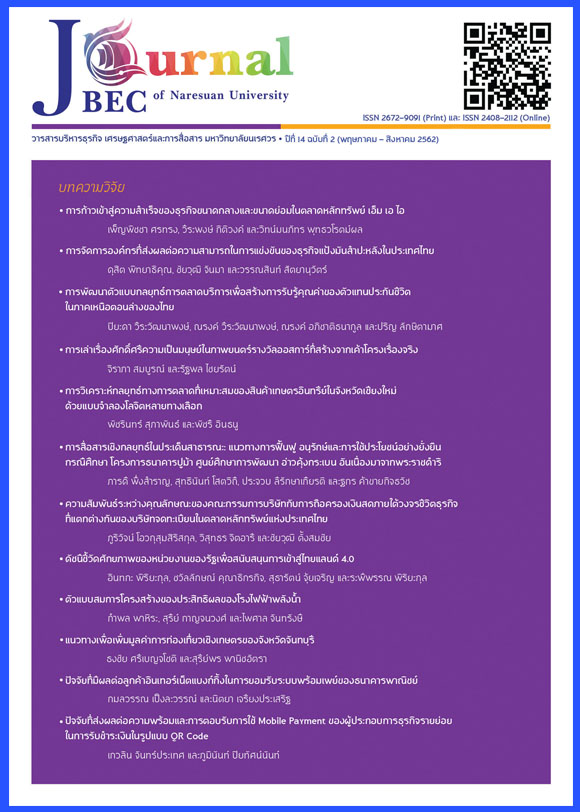ดัชนีชี้วัดศักยภาพของหน่วยงานของรัฐเพื่อสนับสนุนการเข้าสู่ไทยแลนด์ 4.0
Main Article Content
บทคัดย่อ
การขาดดัชนีชี้วัดความสำเร็จ ย่อมส่งผลต่อการส่งเสริมและการสนับสนุนการจัดการการดำเนินงานขององค์การ ดังนั้นการวิจัยครั้งนี้มีวัตถุประสงค์เพื่อสำรวจข้อมูลที่สนับสนุนโดยตรงหรือโดยอ้อมเพื่อใช้ในการจัดทำดัชนีวัดความสำเร็จของการเป็น “ประเทศไทย 4.0 (TI4)” โดยศึกษาเฉพาะหน่วยงานของรัฐที่มีหน้าที่สนับสนุนพิธีการทางธุรกิจ การศึกษาครั้งนี้เป็นการวิจัยเชิงผสมผสาน ระหว่างปริมาณและคุณภาพ เพื่อศึกษาปัจจัยต่าง ๆ ในหลายมิติ ผลการศึกษาสามารถให้แนวทางในการจัดทำดัชนีประเทศไทย 4.0 ในระดับจุลภาค และระดับมหภาค โดยดัชนีระดับจุลภาคมีเป้าหมายเพื่อใช้ในการประเมินตนเอง ในศักยภาพในการบริหารโครงสร้างพื้นฐานด้านไอซีทีร่วมกับทรัพยากรอื่น ๆ ส่วนดัชนีมหภาคเป็นดัชนีมาตรฐานของการรัฐบาลอิเล็กทรอนิกส์เพื่อใช้เปรียบเทียบกับประเทศอื่น ๆ
Article Details

This work is licensed under a Creative Commons Attribution-NonCommercial-NoDerivatives 4.0 International License.
References
2. Barney, J. (1991). Firm resources and sustained competitive advantage. Journal of Management, 17(1), 99-120.
3. Bhattacherjee, A. (2001). Understanding information systems continuance: An expectation-confirmation model. MIS Quarterly, 25(3), 351-370.
4. Blumler, J. G. and Katz, E. (1974). The uses of mass communications: Current perspectives on gratifications research. Beverly Hills, CA: Sage.
5. Charutwinyo, C. (2016). The analysis of networked readiness inbok model. Journal of Business, Economics and Communications, 13(2), 73-91.
6. Coyle-Shapiro, J. A. M. and Conway, N. (2004). The employment relationship through the lens of social exchange theory. UK: Oxford University Press.
7. Davis, F. D, Bagozzi, P. R. and Warshaw, P. (1989). User acceptance of computer technology: A comparison of two theoretical models. Management Science, 35(8), 982-1003.
8. Department of Industrial Promotion. (2017). Business adaptation 4.0. Retrieved September 12, 2017, from https://bsid.dip.go.th/th/category/marketing2/sm-adjustbusiness/
9. Eccles, R. G. and Pyburn, P. J. (1992). Creating a comprehensive system to measure Performance. Management Accounting (USA), 74(4), 41-44.
10. Hawawini, G. and Viallet, C. (2002). Finance for executives (2nd ed.). New York: Thomson South-Western.
11. Helfat, C. E. and Peteraf, M. A. (2003). The dynamic resourcebased view: Capability lifecycles. Strategic Management Journal, 24(10), 997-1010.
12. Horvat, D. and Trojak, N. (2013). Learning organization in new economy. Interdisciplinary Management Research, 9, 183-195.
13. Jiyong, K. (2013). Effects of reputation and website quality on online consumers' emotion, received risk and purchase intension. Journal of Research in Interactive Marketing, 7(2), 33-56.
14. Kaplan, R. S. and Anderson, S. R. (2007). Time-Driven Activity-Based Costing. Boston: HBS.
15. King Prajadhipok's Institute. (2016). Report of the King Prajadhipok's Institute. Bankok: King Prajadhipok's Institute.
16. Makhija, N., Brady-Amoon, P., Dixit, V. and Jonathan, D. (2012). Social Justice: Pushing Past Boundaries in Graduate Training. Journal for Social Action in Counseling and Psychology, 4(2), 85-97.
17. National Statistical Office. (2016). Report of National Statistical Office. Bangkok: National Statistical Office.
18. Penrose, E. (1980). The theory of the growth of the firm. New York: Wiley.
19. Sherif, K., Hoffman, J. and Thomas, B. (2006). Can technology build organizational social capital: The case of a global IT consulting firm. Information and Management, 43(7), 795-804.
20. Solow, R. M. (1956). A contribution to the theory of economic growth. The Quarterly Journal of Economics, 70(1), 65-94.
21. Termpittayapaisith, A. (2013). The Next Generation of Thai Industry. Bangkok: Office of the National Economic and Social Development Board (NESDB).
22. United Nations Department of Economic and Social Affairs (UNDESA). (2018). Index of EGDI compared with Thailand, Vietnam, Indonesia and Singapore. New York: Two UN Plaza-Room DC2-1712.
23. Vashakmadze, T. (2008). Calculating equity risk premium for Russian market – An empirical analysis. Global Academy Society Journal: Social Science Insight, 1(5), 4-15.
24. Yoshino, N. and Sakakibara, E. (2015). The current sate of the Japanese economy and remedies. Asian Economic Papers, 1(2), 110-126.

